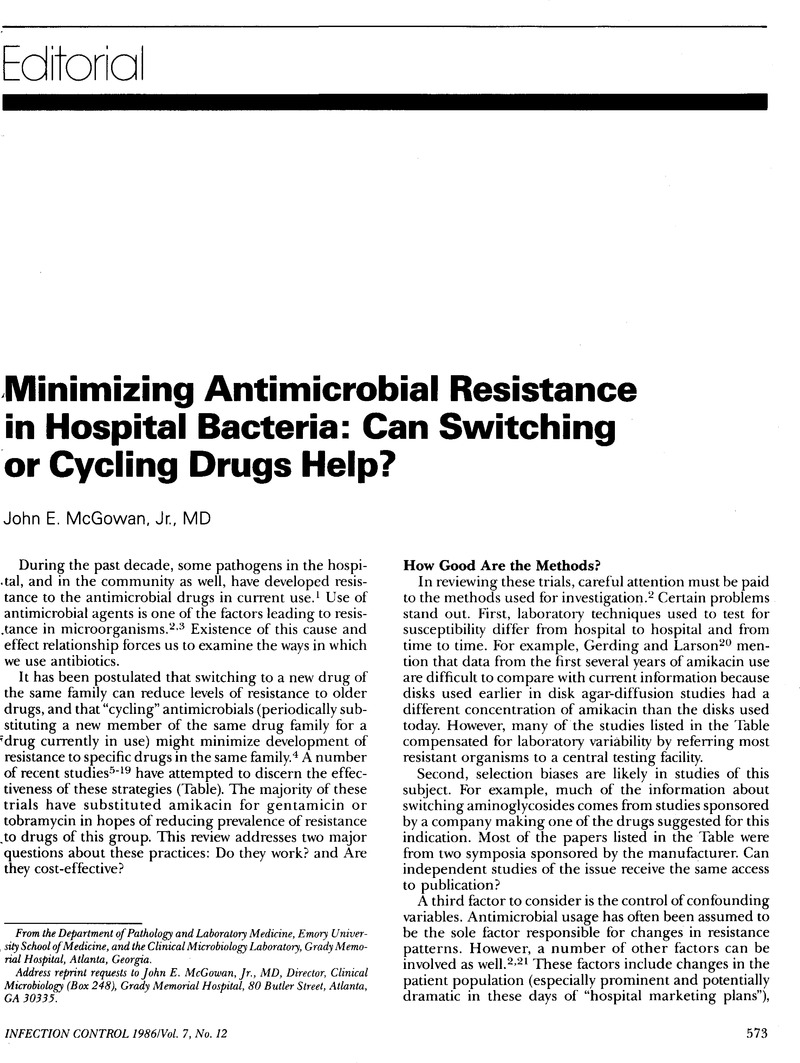Crossref Citations
This article has been cited by the following publications. This list is generated based on data provided by Crossref.
McGowan, John E.
1990.
Improving Antibiotic Use Has Become Essential—Can Surgery Lead the Way?.
Infection Control and Hospital Epidemiology,
Vol. 11,
Issue. 11,
p.
575.
McGowan, John E.
1990.
Improving Antibiotic Use Has Become Essential-Can Surgery Lead the Way?.
Infection Control & Hospital Epidemiology,
Vol. 11,
Issue. 11,
p.
575.
McGowan, J.E.
1991.
Abrupt changes in antibiotic resistance.
Journal of Hospital Infection,
Vol. 18,
Issue. ,
p.
202.
McGowan, John E.
1994.
Do Intensive Hospital Antibiotic Control Programs Prevent the Spread of Antibiotic Resistance?.
Infection Control & Hospital Epidemiology,
Vol. 15,
Issue. 7,
p.
478.
McGowan, John E.
1994.
Do Intensive Hospital Antibiotic Control Programs Prevent the Spread of Antibiotic Resistance?.
Infection Control & Hospital Epidemiology,
Vol. 15,
Issue. 7,
p.
478.
Schentag, Jerome J
Paladino, Joseph A
Birmingham, Mary C
Zimmer, Gabrial
Carr, James R
and
Hanson, Stephen C
1995.
Use of Benchmarking Techniques to Justify the Evolution of Antibiotic Management Programs in Healthcare Systems.
Journal of Pharmacy Technology,
Vol. 11,
Issue. 5,
p.
203.
Bonhoeffer, Sebastian
Lipsitch, Marc
and
Levin, Bruce R.
1997.
Evaluating treatment protocols to prevent antibiotic resistance.
Proceedings of the National Academy of Sciences,
Vol. 94,
Issue. 22,
p.
12106.
Shlaes, David M.
Gerding, Dale N.
John, Joseph F.
Craig, William A.
Bornstein, Donald L.
Duncan, Robert A.
Eckman, Mark R.
Farrer, William E.
Greene, William H.
Lorian, Victor
Levy, Stuart
McGowan, John E.
Paul, Sindy M.
Ruskin, Joel
Tenover, Fred C.
and
Watanakunakorn, Chatrchai
1997.
Society for Healthcare Epidemiology of America and Infectious Diseases Society of America Joint Committee on the Prevention of Antimicrobial Resistance: Guidelines for the Prevention of Antimicrobial Resistance in Hospitals.
Infection Control and Hospital Epidemiology,
Vol. 18,
Issue. 4,
p.
275.
Shlaes, David M.
Gerding, Dale N.
John, Joseph F.
Craig, William A.
Bornstein, Donald L.
Duncan, Robert A.
Eckman, Mark R.
Farrer, William E.
Greene, William H.
Lorian, Victor
Levy, Stuart
McGowan, John E.
Paul, Sindy M.
Ruskin, Joel
Tenover, Fred C.
and
Watanakunakorn, Chatrchai
1997.
Society for Healthcare Epidemiology of America and Infectious Diseases Society of America Joint Committee on the Prevention of Antimicrobial Resistance Guidelines for the Prevention of Antimicrobial Resistance in Hospitals.
Infection Control & Hospital Epidemiology,
Vol. 18,
Issue. 4,
p.
275.
Spencer, Robert C
Bauernfeind, Adolf
Garcia-Rodriguez, Jose
Jarlier, Vincent
Pfaller, Michael
Turnidge, John
and
Voss, Andreas
1997.
Surveillance of the current resistance of nosocomial pathogens to antibacterials.
Clinical Microbiology and Infection,
Vol. 3,
Issue. ,
p.
S21.
McGowan, John E.
and
Tenover, Fred C.
1997.
CONTROL OF ANTIMICROBIAL RESISTANCE IN THE HEALTH CARE SYSTEM.
Infectious Disease Clinics of North America,
Vol. 11,
Issue. 2,
p.
297.
Stewart, F.M.
Antia, R.
Levin, B.R.
Lipsitch, M.
and
Mittler, J.E.
1998.
The Population Genetics of Antibiotic Resistance II: Analytic Theory for Sustained Populations of Bacteria in a Community of Hosts.
Theoretical Population Biology,
Vol. 53,
Issue. 2,
p.
152.
Mainardi, Jean Luc
Carlet, Jean
and
Acar, Jacques
1998.
ANTIBIOTIC RESISTANCE PROBLEMS IN THE CRITICAL CARE UNIT.
Critical Care Clinics,
Vol. 14,
Issue. 2,
p.
199.
Cunha, Burke A.
1998.
ANTIBIOTIC RESISTANCE.
Critical Care Clinics,
Vol. 14,
Issue. 2,
p.
309.
Roth, Virginia R
and
Jarvis, William R
1999.
Combating antimicrobial resistance in hospitals.
Emerging Therapeutic Targets,
Vol. 3,
Issue. 1,
p.
73.
Demey, Hendrik E.
Jansens, Hilde
Van Laer, Frank
Ieven, Margareta
Goossens, Herman
and
Bossaert, Leo L.
1999.
Strategies for selecting antibiotics in intensive care units.
Clinical Microbiology and Infection,
Vol. 5,
Issue. ,
p.
S29.
Monnet, Dominique L.
Sørensen, Thomas L.
and
Jepsen, Ole B.
2000.
Implementation of a Practical Antibiotic Policy in the Czech Republic.
Infection Control & Hospital Epidemiology,
Vol. 21,
Issue. 1,
p.
7.
Lipsitch, Marc
Bergstrom, Carl T.
and
Levin, Bruce R.
2000.
The epidemiology of antibiotic resistance in hospitals: Paradoxes and prescriptions.
Proceedings of the National Academy of Sciences,
Vol. 97,
Issue. 4,
p.
1938.
John, Joseph F.
2000.
Antibiotic Cycling: Is It Ready for Prime Time?.
Infection Control & Hospital Epidemiology,
Vol. 21,
Issue. 1,
p.
9.
Dominguez, Edward A.
Smith, Theresa L.
Reed, Elizabeth
Sanders, Christine C.
and
Sanders, W. Eugene
2000.
A Pilot Study of Antibiotic Cycling in a Hematology-Oncology Unit.
Infection Control & Hospital Epidemiology,
Vol. 21,
Issue. S1,
p.
S4.



